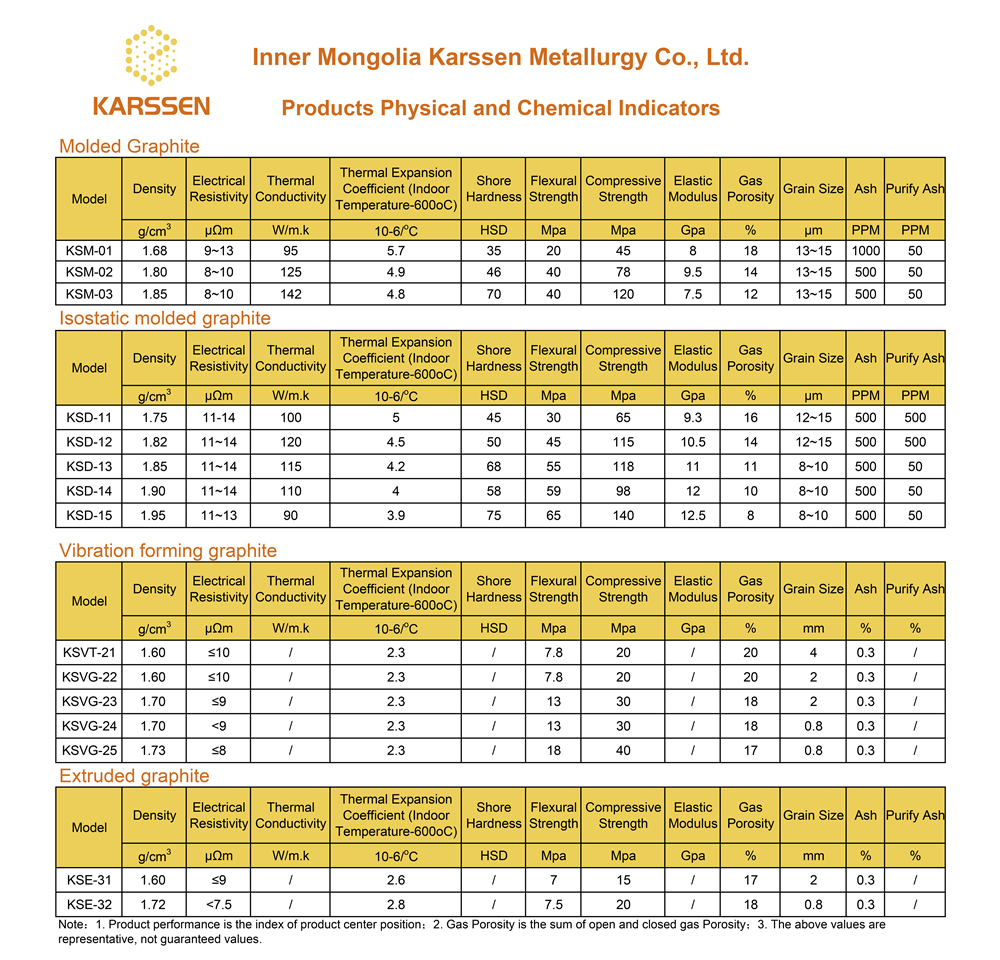Email: info@karssenmetal.com Tel: +86 18147353336
Graphite Sintering Boat

At present, graphite molds are widely used in the following aspects:
1. Graphite molds for non-ferrous metal continuous casting and semi-continuous casting: In recent years, advanced production methods such as direct continuous (or semi-continuous) manufacturing of rods or pipes from the molten metal state are being promoted at home and abroad. foreign. This method has begun to be applied to copper, copper alloys, aluminum, aluminum alloys, etc. in China. Artificial graphite is considered to be the most suitable material for non-ferrous metal continuous casting or semi-continuous casting molds. Production practice has proved that due to the use of graphite molds, good thermal conductivity (thermal conductivity determines the solidification speed of metal or alloy), good self-lubricating properties of the mold and other factors, not only the casting speed is increased, but the size of the ingot is also increased. Casting speed. It has high precision, smooth surface and uniform crystal structure, and can be directly processed in the next process. This not only greatly improves the yield rate and reduces waste loss, but also greatly improves product quality. There are two continuous casting methods: vertical continuous casting and horizontal continuous casting.
2. Molds for pressure casting: Artificial graphite materials have been successfully used in non-ferrous metal pressure casting. For example, zinc alloy and copper alloy castings produced by die-casting molds made of artificial graphite materials have been used in automobile parts and other aspects.
3. Graphite mold for centrifugal casting: Graphite mold has been successfully used in centrifugal casting. The United States has used artificial graphite molds with a wall thickness of more than 25 mm to centrifugally cast bronze shells. In order to prevent artificial graphite molds from burning, certain anti-oxidation measures can be taken. After casting a certain number of castings, if it is found that the inner surface of the casting mold is burnt, the size of the inner hole of the casting mold can be enlarged so that it can be used for casting large-size casings.
4. Hot pressing mold: Artificial graphite hot pressing mold is used for pressure sintering of cemented carbide and has the following characteristics: First, the pressing temperature is increased to 1350-1450 degrees, and the required unit pressure can be reduced to 67-100 kgf/cm2 (i.e. cold 1/10 of the pressing force) is enough; secondly, pressing and heating are carried out in the same process, and a dense sintered body can be obtained after a short period of sintering.
5. Mold for glass molding: Due to the chemical stability of graphite material, it is not easily penetrated by molten glass and will not change the composition of the glass. Graphite material has good thermal shock resistance and small size changes with temperature. Therefore, glass has been widely used in molds in recent years. It has become an indispensable mold material in manufacturing and can be used to make molds for glass tubes, elbows, funnels and other special-shaped glass bottles.
6. Sintering molds and other diamond sintering molds: Taking advantage of the extremely small thermal deformation of artificial graphite materials, sintering molds and brackets for transistors can be manufactured. It has been widely used and has become an indispensable material for the development of the semiconductor industry. In addition, graphite molds are also used in casting molds for cast iron, durable casting molds for various non-ferrous metals, casting molds for cast steel, casting molds for heat-resistant metals (titanium, zirconium, molybdenum, etc.) and aluminum. Graphite molds for hot-pressed sintered diamond tools play the dual roles of heating elements and mold supports in the diamond tool manufacturing process. The quality of graphite molds directly affects the dimensional accuracy and appearance of diamond tools. Hot pressing sintering process requirements: the temperature reaches (1 000 ± 2) ℃, the molding pressure is 16 to 50 MPa, the heat and pressure holding time is 15 to 30 minutes, and the environment is in a non-vacuum state. Under these working conditions, graphite molds for forming and heating elements are required to have electrical conductivity, high resistivity and sufficient mechanical strength. It also needs to have good oxidation resistance and long service life to ensure the dimensional accuracy and excellent performance of diamond tools. At present, the graphite mold materials used in diamond tool manufacturing in Western developed countries are mainly graphite materials with ultra-fine particle structure, high purity, and high degree of graphitization. The average particle size is required to be less than 15 μm, or even less than 10 μm, and the mesopore size is less than 2 μm. Graphite molds made of this carbon raw material have small porosity, dense structure, high surface finish, strong oxidation resistance, and an average service life of 30 to 40 times. Diamond molds require high material hardness, good oxidation resistance, and high processing accuracy. The use of high-quality graphite raw materials greatly extends the service life of the mold and improves the oxidation resistance.
Isostatic graphite blocks are an important graph
Graphite rotor belongs to graphite material, whi
Graphite sheets have many important roles in the
Contact: Bateer
Phone: +86 18147353336
Tel: +86 18147353336
Email: info@karssenmetal.com
Add: Room D204-2203, Innovation Building, Baotou Light Industry Vocational Technical College, 19 Jianhua Road, Qingshan District, Baotou City, Inner Mongolia, China.